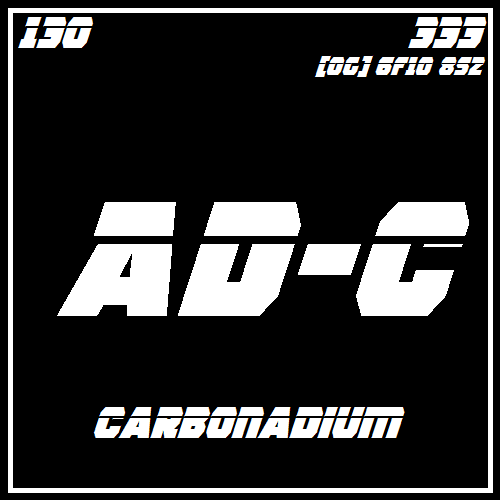Introduction
Carbonadium, symbol Ad-C, with an atomic number of 130 and an atomic weight of 333, is a fascinating fictional element from the Oganesson (Og) series. Known for its unique properties and significant role in various media, Carbonadium is a form of adamantium developed in the USSR. This element is notable for its almost equal strength to adamantium, flexibility, and toxic radiation emission, which can impede superhuman healing factors.
Imaginary History
Carbonadium was first synthesized in a secret Soviet laboratory during the height of the Cold War. The goal was to create a material that could rival and potentially surpass the legendary adamantium. Soviet scientists, using advanced nuclear and metallurgical techniques, managed to produce Carbonadium. The material quickly became a closely guarded secret due to its unique properties and potential military applications.
Properties of Carbonadium
Strength and Flexibility
One of the most remarkable features of Carbonadium is its combination of strength and flexibility. While it is nearly as strong as adamantium, Carbonadium is significantly more pliable, making it ideal for creating items that require both durability and flexibility. This unique combination has made it a sought-after material for various applications in the fictional world.
Toxic Radiation
Carbonadium emits a form of toxic radiation that can interfere with superhuman healing factors. This property makes it a double-edged sword; while its strength and flexibility are advantageous, the radiation it emits can be harmful, even lethal, to those who come into prolonged contact with it.
Electron Configuration
The electron configuration of Carbonadium is [Og] 6f10 8s2. This configuration places it in the Oganesson series, contributing to its heavy atomic weight and unique nuclear properties.
Source in Media
Carbonadium has appeared in various forms of media, particularly within the Marvel Universe. It is best known for its association with the anti-hero Deadpool and the villain Omega Red.
Deadpool's Katanas
Deadpool, the infamous "Merc with a Mouth," wields katanas made from Carbonadium. These weapons benefit from the material's strength and flexibility, allowing Deadpool to use them with exceptional skill and efficiency. The toxic radiation emitted by the katanas also gives Deadpool an edge against opponents with regenerative abilities.
Omega Red's Tentacles
Omega Red, a Soviet super-soldier and recurring villain in the X-Men series, has retractable metal tentacles made from Carbonadium. These tentacles are not only incredibly durable and flexible but also emit radiation that can weaken and ultimately kill his enemies. Omega Red's tentacles are a testament to Carbonadium's lethal potential.
Moon Knight's Armor
In the third series of the Moon Knight comic, the titular hero's armor suit is reinforced with Carbonadium. This addition enhances Moon Knight's durability and combat effectiveness, providing him with a robust defense against his numerous adversaries.
Alloys and Compounds
While Carbonadium itself is a potent material, it can also form various alloys and compounds that enhance its properties or make it suitable for specific applications.
Carbonadium-Alloyed Steel
One of the most notable alloys is Carbonadium-alloyed steel. This material combines the strength and flexibility of Carbonadium with the structural integrity of steel, making it ideal for constructing high-durability structures and equipment.
Carbonadium-Infused Armor
Armor infused with Carbonadium provides unparalleled protection against physical and energy-based attacks. This type of armor is used by various characters in the Marvel Universe, offering them a significant advantage in combat situations.
Importance in Stories
Carbonadium's unique properties have made it a critical element in numerous storylines. Its strength, flexibility, and toxic radiation have allowed writers to create compelling narratives and formidable adversaries.
Deadpool and Omega Red
The rivalry between Deadpool and Omega Red is a prime example of Carbonadium's importance. The material's ability to counteract regenerative powers adds a layer of complexity to their encounters, making their battles more intense and unpredictable.
Moon Knight's Resurgence
Moon Knight's use of Carbonadium in his armor signifies the character's evolution and adaptation. The material's inclusion symbolizes Moon Knight's preparedness to face increasingly powerful foes, reflecting his growth as a hero.
Secret Facts About Carbonadium
Soviet Origins
The creation of Carbonadium was a significant achievement for Soviet scientists. Its development during the Cold War highlights the intense competition between superpowers and their relentless pursuit of superior technology.
Limited Production
Due to the complexity of its synthesis and the dangers associated with its radiation, Carbonadium production was limited. This scarcity adds to its mystique and value, making items made from Carbonadium rare and highly coveted.
Hidden Weaknesses
While Carbonadium is incredibly durable, it is not invincible. Prolonged exposure to certain energy fields can destabilize its atomic structure, rendering it brittle and susceptible to damage. This vulnerability is a closely guarded secret known only to a few.
Conclusion
Carbonadium is a fascinating and multifaceted fictional element with a rich history and significant impact on the stories it inhabits. Its unique combination of strength, flexibility, and toxic radiation has made it a valuable and dangerous material. Whether it's Deadpool's lethal katanas, Omega Red's deadly tentacles, or Moon Knight's reinforced armor, Carbonadium continues to captivate the imagination of fantasy and sci-fi fans, TTRPG and MMORPG players, cosplayers, roleplayers, prop makers, and weird science buffs. Its enduring presence in media underscores its importance and the allure of its mysterious properties.

